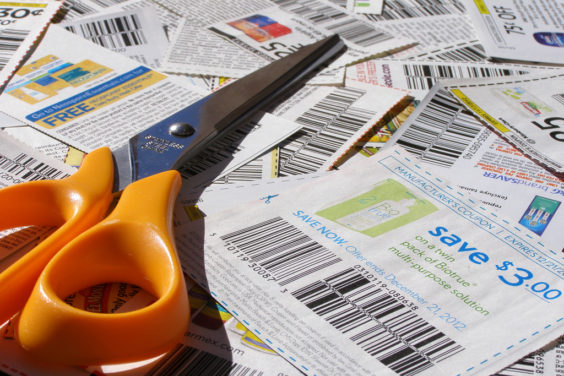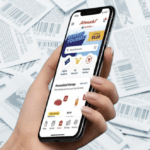Just when you think the numbers couldn’t fall any further, new findings about the number of coupons available and the number redeemed so far this year show both of them hitting new lows. It’s the same story we’ve heard for a number of years now. But the rate of decline is increasing rapidly – and if someone doesn’t slam on the brakes soon, saving a significant amount of money by using coupons could become darned near impossible.
Inmar has released the results of its annual Mid-Year Promotion Industry Analysis, taking stock of the state of coupons halfway through the year. And if you like coupons, it’s looking a little grim.
Coupon distribution fell off the proverbial cliff in the first half of 2018. After several years of holding relatively steady at about 170 billion, the number of coupons available in the first six months of 2018 fell to just 148 billion – a steep 12.8% decline. Historically, even fewer coupons are distributed in the second half of each year. So unless coupon distribution defies all expectations this year, it’s looking like we’re on pace to fall far short of last year’s total of 302 billion coupons distributed, which was already the lowest figure in a decade.
With fewer coupons available, the number of coupons redeemed so far this year fell accordingly. This time last year, 1.04 billion coupons had been redeemed. So far this year, that figure has dipped below the one billion mark, to just 900 million – a 13.2% decline. By year’s end, at the current pace, that figure is also likely to fall far short of 2017’s year-end total of 2 billion coupons redeemed, which was the lowest in more than four decades.
The declining rate of coupon use has led to all kinds of analysis – do fewer shoppers care about coupons anymore? Are they doing more shopping online, buying more prepared meals, shopping at stores that don’t accept coupons? All of that is true – but it’s worth noting that, as a percentage of coupons distributed, the number of coupons redeemed so far this year is actually right on par with last year. So the issue isn’t so much that shoppers aren’t using coupons – it’s that there are so few coupons available for things they’d like to buy, they couldn’t really use any more even if they wanted to.
The coupons that are available, are much less attractive as well. Expiration dates are getting shorter – the average of 1.5 months is down 13% from this time last year. Purchase requirements are increasing – the average coupon requires the purchase of 1.41 items, up 3.2% from last year. About the only good news is that the average face value of coupons is up – way up – to $1.90, an all-time high.
But that’s largely due to the fact that there are more higher-value coupons for higher-value products – that is to say, higher-value nonfood products. Continuing a recent trend, food coupons made up a mere 28.1% of all coupons available so far this year. Five years ago, the split was roughly 40% food, 60% nonfood, while 15 years ago it was just about 50/50. Food coupons, however, made up nearly half of all coupons redeemed, suggesting that coupons for things you can actually eat continue to be more popular and useful than the majority of the coupons that manufacturers are providing.
Paper coupons, particularly those distributed in the Sunday inserts, make up the vast majority of coupons distributed and a plurality of those redeemed. But at 14.5% of all coupons used so far this year, digital coupon use continues to climb, largely at the expense of print-at-home coupons, which now account for only 2.4% of coupons redeemed.
Overall, the numbers provide some cause for concern for couponers – not only because coupons are becoming increasingly unattractive, but because they’re becoming increasingly scarce. Are coupons just not an effective promotional tool anymore?
There are a number of factors that could help explain why there are so few coupons available lately. Distribution of Sunday coupon inserts is down, as newspaper readership declines and as fewer newspapers contain all of the inserts anymore.
Manufacturers are also devoting more resources to in-store promotions and lower regular prices. A 2017 year-end report by market research company Price-Trak noted that “pricing continues to be impacted by retailers lowering retail prices in response to on-line alternatives and shifts in consumer trends. As retailers look to maintain their margins there is more pressure on manufacturers to lower pricing.” So if they’re already charging less on the shelf, there’s little reason to provide an even bigger discount in the form of coupons.
An alternative explanation is that coupons aren’t becoming endangered – they’re just becoming more efficient. The rise of digital coupons means more manufacturers can provide targeted, personalized offers. Instead of flooding the marketplace with billions of coupons that aren’t likely to be used anyway, they can focus their efforts on issuing fewer coupons to select shoppers who are most likely to be influenced by them.
Shoppers aren’t so sure that’s working, though. When asked why they’ve been using fewer coupons this year than last, nearly half of the shoppers surveyed by Inmar said it was because they couldn’t find coupons for the products they wanted to buy.
More isn’t necessarily better, especially when you consider that less than one percent of all coupons issued so far this year were even used. But as long as there are fewer coupons out there, unless you’re the lucky recipient of personalized offers that correspond to everything you like to buy, it’s becoming much more difficult to find coupons that will help make a dent in your grocery budget. And if this is the way things are going so far this year, brace yourself – it could get a lot worse before it gets any better.

















This does not surprise me at all. I never walked around grocery stores with the insert-bundles-in-a-notebook back in the hey-day of extreme couponing in this 2000s, but I bought multiple papers, previewed the ads, used envelopes to sort my stash, and even wrote a blog with all my deals. Then along came the basic cable TV show and the websites, often hyping coupon misuse (either on purpose or by accident) Technology changed and improved. Manufacturers reduced the coupon value, tossed in variables and limitations, and updated their coding.
I still “coupon” but via the digital coupons loaded by individual stores. Sure, you aren’t going to get 40 bottles of shampoo or 700 rolls of paper towels. I still only buy items when they are on sale, and usually only when I have an added discount/coupon/promo that I can load. Plus, I learned that nearly all items go on sale on a somewhat regular basis. The key is to buy at the right time.
For example, Safeway just began a monthlong Anniversary Sale. Two brands that will be on sale all month are Ocean Spray Juices and Chex Mix. Now Ocean Spray is now shelf-priced at a ludicrous $4.49. Who in their right mind would every pay that. It’s on sale, all month, no limits, for $2.00. Plus, because I have bought it in the past, Safeway has given me an unlimited “personal price” of $1.90. Similarly, Chex Mix has gone up to a whopping $2.79 as a shelf price. Outlandish. It’s on sale all month for 99-cents, unlimited. Plus, again thanks to my purchase history, Safeway plops a 50-cents off two coupon into my profile. It replenishes after every use.
So by using the Just4U program, I can stock up on juice and snacks to last me for 3-4 months. Both of those items will go back on sale before the holidays (and again around Super Bowl time — and likely again around Memorial Day).
No need to hunt for paper coupons.